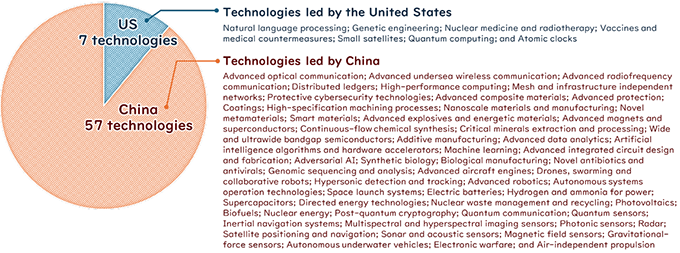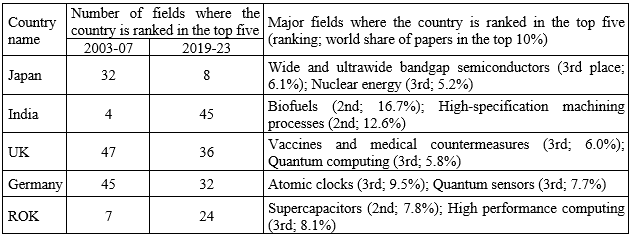While technology competition has been intensifying globally, it is becoming increasingly important to ascertain technological capabilities of individual countries from the viewpoint of security and economic development. The "Critical Technology Tracker" (hereinafter, the "Tracker"), which the Australian Strategic Policy Institute (ASPI) published at the end of August 2024, analyses scientific and technological capabilities of individual countries in 64 critical technologies, such as defence, energy, space, and AI. Following the first edition (March 2023), which was referenced by various national governments and news media, the latest second edition analyses each country's technological capabilities and technology monopoly risk based on a dataset of research papers covering a 21-year span (from 2003 to 2023) and other data.
Changes in Global Technology Landscape and Current Situation
What is notable is the reversal of the positions of the United States and China due to the technological rise of China. In the early 2000s, the United States was the world leader in many technological fields, but that hierarchy has been completely reversed in the last 20 years. During the period from 2003 to 2007, the United States occupied a leading position in 60 technologies out of 64, but during the period from 2019 to 2023, China took the lead in 57 technologies, while the United States held only seven technologies. Such reversal phenomena are most notable in the advanced materials and manufacturing and communication fields in particular, and in the field of biotechnology in recent years. In critical emerging technology fields, such as AI and quantum technologies, China has rapidly strengthened its leadership and is surpassing the United States in many other fields.

[Click to enlarge]
What should be noted next is the rapid advancement of India. In the early 2000s, India was in the top five countries only in four technologies, but in 2023, it was ranked in the top five in 45 technologies. It is expected that India will surpass China and will gain the world's top position as the only nation other than the United States and China in the field of biofuels in the next few years.
In some fields, technology monopoly risk has been increasing. The Tracker assesses technology monopoly risk based on whether any scientific expertise and high-impact research outcomes have become concentrated in a single country in the last five years. The number of technology fields for which the risk was assessed to be high was 14 in the period from 2003 to 2007 but the relevant number increased to 24 in the period from 2019 to 2023. In particular, defence-related technologies, such as radar and advanced aircraft engines, are newly classified into high-risk fields, and the monopoly by China, which leads these fields, is a matter of concern. A monopoly could lead to military use of the relevant technology and directly affect national security and become a cause of increased global geopolitical risks. It is therefore necessary for individual countries to pursue multilateral cooperation in technological development or otherwise take measures to reduce such risks.
Japan's Technological Competitiveness and Current Challenges
Japan still maintains strengths in several technology fields. In particular, in the fields of semiconductor and nuclear power, Japan has a long history of technological development and advanced specialized knowledge and has maintained third place, following China and the United States (in the fields of wide and ultrawide bandgap semiconductors and nuclear energy). In addition to these two fields, Japan is ranked in the top five in the fields of advanced magnets and superconductors, genetic engineering, genomic sequencing and analysis, quantum computing, quantum sensors, and atomic clocks. However, in seven fields out of these eight in total, Japan has fallen in the rankings and has lost global market share. Given this fact and the fact that Japan was ranked in the top five in 32 technologies in the early 2000s, this can be said to be a significant setback for Japan.
Based on the data of the Tracker, it seems that there were significant declines in Japan's rankings in various technologies; specifically in the fields of advanced information and communication technologies (advanced radiofrequency communication, protective cybersecurity technologies, etc.), defence, space, robotics and transportation (drones, swarming and collaborative robots, and advanced robotics), energy and the environment (photovoltaics, biofuels, etc.) and other technologies. Japan's rankings also declined in the fields with high technology monopoly risk (nanoscale materials and manufacturing, smart materials, advanced aircraft engines, advanced undersea wireless communication, photonic sensors, etc.), and it can be said that technology availability and access in Japan are threatened.
While Japan has been losing technological capabilities, the ROK has achieved significant growth in the AI and energy fields and has almost surpassed Japan in these last 20 years. The ROK, which was ranked in the top five only in seven technologies in the early 2000s, is ranked in the top five in 24 technologies, mainly in the AI and energy and environment fields, according to the latest data.

Risk Assessment for Critical Technologies
In light of the heightening technology monopoly risk, it is necessary to assess risks based on the possibility that monopolized technologies could become unavailable and to consider countermeasures. I have served as an official at the Ministry of Economy, Trade and Industry, but I am currently engaged in research in the United Kingdom on the assessment of risks associated with the availability and access of emerging critical technologies. I would like to introduce the approach used for the research. In risk assessment, it is common to combine the probability of a risk and the level of its impact. In the research, this common practice is applied in assessing risks associated with the technology availability and access. The risk probability of a certain technology becoming unavailable or inaccessible (or the availability and access of a technology) is defined as "whether it is possible for a country to obtain some specific technology domestically or from abroad and to actually utilize that technology in research and development and industrial activities in the country." For example, when advanced research on a specific technology has progressed to a particular necessary level and the capacity of the industry is high in a country, it can be said that the availability of that technology is high (the probability that the relevant technology becomes unavailable is low) in that country. However, if that technology is monopolized by another country, or if the country lacks human resources who understand and can fully utilize that technology, or if legal regulations are strict and public opposition is strong, it can be said that the technology’s availability and access are low (the probability that the relevant technology becomes unavailable is high) in that country. Another factor is the level of influence when a certain technology is unavailable. If there is an alternative technology, the influence of monopolization is small, but if stable operation of critical infrastructure cannot be ensured without that technology or if a country's industrial competitiveness would be significantly damaged without that technology, the influence is large. The development of a concrete quantification method for the influence of the unavailability of technologies is a future challenge.
In response to the shifting global technology landscape, interest in technology risk assessment is increasing. In the United States, the Directorate for Technology, Innovation and Partnerships, which was established in the National Science Foundation (NSF) based on the CHIPS Act in 2022, launched an award-based support program through the "Assessing and Predicting Technology Outcomes" (APTO) project. This program provides rewards for results, rather than research and development processes, including through competitions. It will also be necessary to consider how to assess the availability of technologies and risks regarding the influence thereof in Japan, together with the academic community. Various organizations such as the JST Center for Research and Development Strategy, the NEDO Technology and Innovation Strategy Center, and the Think Tank on Safety and Security, for which preparation work has been conducted by the Cabinet Office, are expected to work to strengthen the link between the government, academia and overseas organizations, such as the NSF in the United States and the ASPI in Australia, thereby promoting full-scale efforts for risk assessment for critical technologies.
August 24, 2024
>> Original text in Japanese


